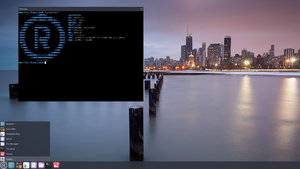 | |
 Redox running Ion shell in Orbital windowing system | |
| Developer | Jeremy Soller, Redox Developers[1] |
|---|---|
| Written in | Rust, assembly |
| OS family | Unix-like |
| Working state | Current |
| Source model | Free software |
| Initial release | 20 April 2015 |
| Latest preview | 0.9.0 / 9 September 2024 |
| Repository | |
| Marketing target | Desktop, workstation, server |
| Available in | English |
| Package manager | pkgutils |
| Platforms | x86-64; ARM64 in development[2] |
| Kernel type | Microkernel |
| Userland | Custom |
| Influenced by | POSIX[3] |
| Default user interface | Command-line, Orbital |
| License | MIT |
| Official website | www |
Redox is a Unix-like microkernel operating system written in the programming language Rust, which has a focus on safety, stability, and performance.[4][5][6] Redox aims to be secure, usable, and free. Redox is inspired by prior kernels and operating systems, such as SeL4, MINIX, Plan 9, BSD, and Linux. It is free and open-source software distributed under an MIT License.
Redox gets its name from the reduction-oxidation reactions in chemistry; one redox reaction is the corrosion of iron, also called rust.
- ^ "Redox Contributors". GitLab. Retrieved 24 March 2019.
- ^ "Porting Redox to ARM (AArch64)". 6 August 2018.
- ^ "What is Redox?". Archived from the original on 24 May 2020. Retrieved 16 May 2020.
- ^ "Redox - Your Next(Gen) OS - Redox - Your Next(Gen) OS". www.redox-os.org.
- ^ Weisinger, Dick (4 May 2016). "Operating Systems: Rust Redox – An Next-Generation Attempt to Plug Linux OS Gaps". Formtek. Formtek, Inc. Retrieved 17 January 2017.
- ^ . Yegulalp, Serdar (21 March 2016). "Rust's Redox OS could show Linux a few new tricks". InfoWorld. San Francisco: IDG Communications, Inc. Retrieved 17 January 2017.